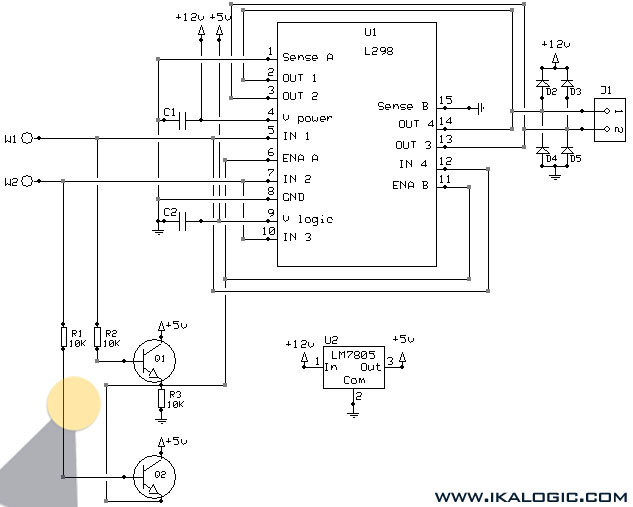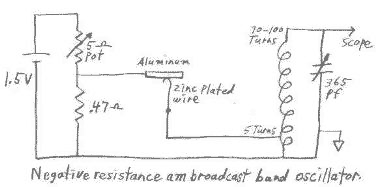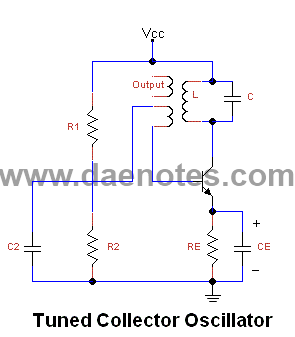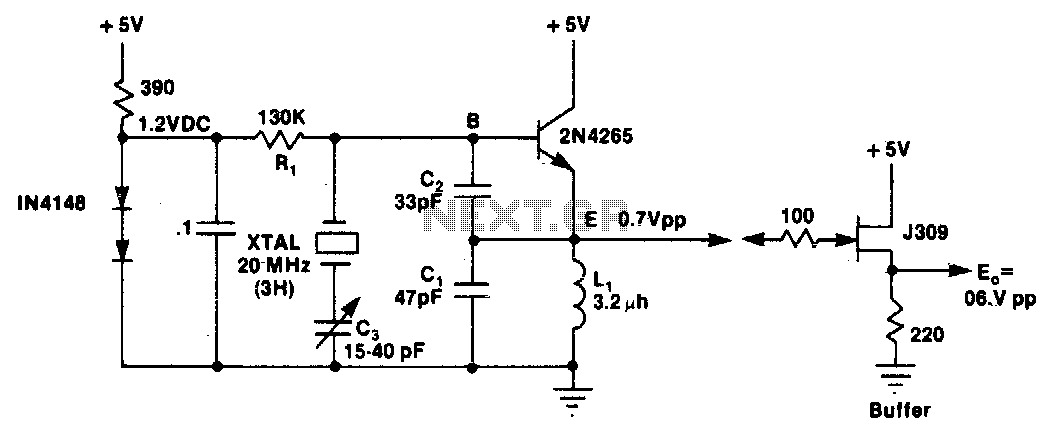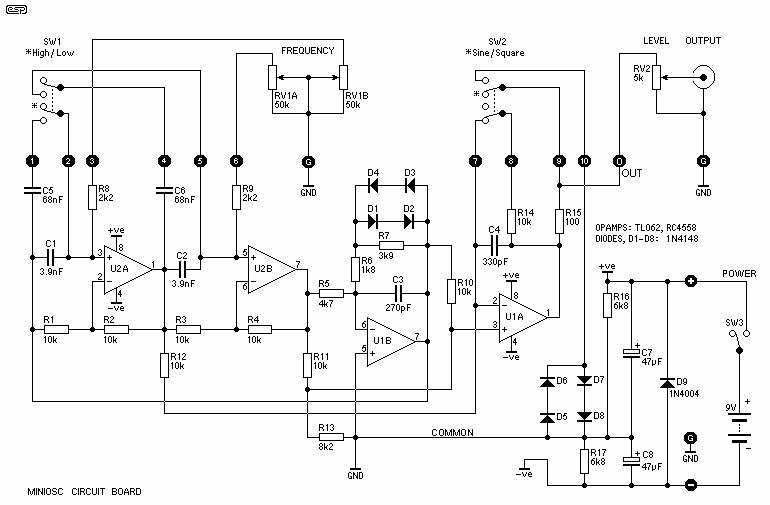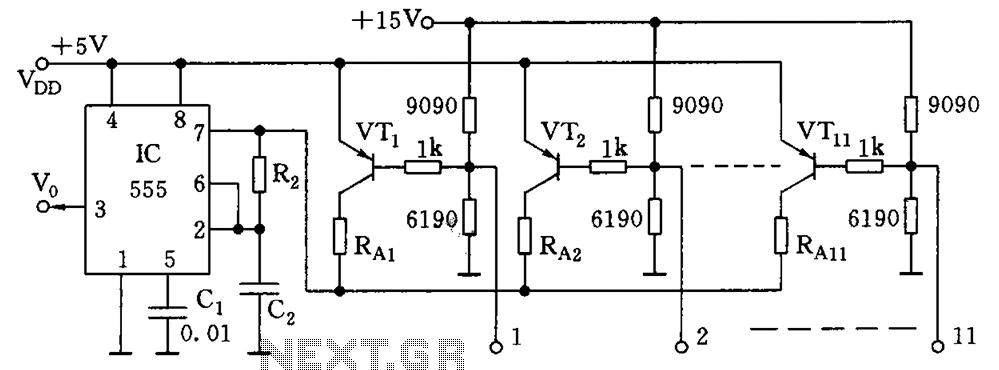
Wien Bridge Oscillator

The Wien bridge oscillator is one of the most popular types of oscillators used in audio and sub-audio frequency ranges (20 Hz to 20 kHz). This oscillator features a simple design, compact size, and remarkable stability in frequency output. Its output is relatively free from distortion, and the frequency can be easily varied. However, the maximum frequency output of a typical Wien bridge oscillator is approximately 1 MHz. It functions as a phase-shift oscillator, utilizing two transistors, each producing a phase shift of 180 degrees, resulting in a total phase shift of 360 degrees or 0 degrees. The oscillator comprises a two-stage amplifier with an R-C bridge circuit, known as the Wien bridge. This R-C bridge circuit acts as a lead-lag network, where the phase shift across the network lags with increasing frequency and leads with decreasing frequency. By incorporating a Wien-bridge feedback network, the oscillator becomes sensitive to a signal of only one specific frequency, which is the frequency at which the Wien bridge is balanced, corresponding to a phase shift of 0 degrees. If the Wien-bridge feedback network is not utilized and the output of transistor Q2 is fed back to transistor Q1 for the necessary regeneration to produce oscillations, transistor Q1 would amplify signals over a wide frequency range, leading to poor frequency stability due to direct coupling. Thus, employing the Wien-bridge feedback network enhances frequency stability. This bridge circuit can serve as a feedback network for an oscillator, provided that the phase shift through the amplifier is zero. This condition is achieved using a two-stage amplifier, as illustrated in the schematic. In this configuration, the output of the second stage is fed back to the feedback network, and the voltage across the parallel combination of C2 and R2 is supplied to the input of the first stage. Transistor Q1 acts as both the oscillator and amplifier, while transistor Q2 functions as an inverter to create a phase shift of 180 degrees. The circuit employs both positive and negative feedback. Positive feedback occurs through R1, C1, R2, and C2 to transistor Q1, while negative feedback is provided through a voltage divider to the input of transistor Q1. Resistors R3 and R4 stabilize the output amplitude. The two transistors, Q1 and Q2, together create a total phase shift of 360 degrees, ensuring proper positive feedback. Negative feedback is implemented to maintain a constant output across a range of frequencies. This is accomplished by using resistor R4 in the form of a temperature-sensitive lamp, whose resistance increases with rising current. If the output amplitude increases, more current leads to greater negative feedback, thereby restoring the output to its original value. Conversely, if the output decreases, a reverse action occurs. This corresponds with a feedback network attenuation of 1/3, necessitating that the voltage gain A must be equal to or greater than 3 to sustain oscillations. Achieving a voltage gain of 3 is straightforward, while maintaining a gain as low as 3 may present challenges, highlighting the importance of negative feedback. The circuit initiates oscillation through any random change in the base current of transistor Q1, which may arise from inherent noise in the transistor or variations in the DC supply voltage. This variation in base current is amplified in the collector circuit of transistor Q1, but with a phase shift of 180 degrees. The output of transistor Q1 is then fed to the base of transistor Q2 through capacitor C4, producing a further amplified and phase-reversed signal at the collector of transistor Q2. Following two inversions, the output signal is in phase with the input signal to the base of transistor Q1. A portion of the output signal from transistor Q2 is fed back to the input points of the bridge circuit (points A-C), with part of this feedback signal being applied to the emitter resistor.
The Wien bridge oscillator circuit consists of a configuration that includes two operational amplifiers (or transistors) arranged in a feedback loop with a Wien bridge network composed of resistors and capacitors. The R-C components are carefully selected to establish the desired oscillation frequency. The resistors R1 and R2 form the arms of the bridge, while capacitors C1 and C2 determine the phase shift characteristics. The transistors Q1 and Q2 are connected in such a way that they provide the necessary gain and phase inversion to sustain oscillations.
The circuit's stability is enhanced through the use of a thermistor or a light bulb as part of the feedback network, which adjusts the gain dynamically based on the output amplitude. This self-regulating mechanism ensures that the oscillator maintains a consistent output level, preventing distortion and frequency drift. The output can be taken from the collector of transistor Q2, providing a clean sine wave signal suitable for audio applications.
In summary, the Wien bridge oscillator is a versatile and reliable circuit used in various audio applications, characterized by its simplicity, stability, and ability to produce low-distortion waveforms over a wide frequency range. Its design allows for easy frequency adjustments while ensuring that the output remains stable and consistent.It is one of the most popular type of oscillators used in audio and sub-audio frequency ranges (20 20 kHz). This type of oscillator is simple in design, compact in size, and remarkably stable in its frequency output.
Furthermore, its output is relatively free from distortion and its fre quency can be varied easily. However, the maximum freque ncy output of a typical Wien bridge oscillator is only about 1 MHz. This is also, in fact, a phase-shift oscillator. It employs two transistors, each producing a phase shift of 180 °, and thus producing a total phase-shift of 360 ° or 0 °. It is essentially a two-stage amplifier with an R-C bridge circuit. R-C bridge circuit (Wien bridge) is a lead-lag network. The phase`-shift across the network lags with increasing frequency and leads with decreasing frequency.
By adding Wien-bridge feedback network, the oscillator becomes sensitive to a signal of only one particular frequency. This particular frequency is that at which Wien bridge is balanced and for which the phase shift is 0 °.
If the Wien-bridge feedback network is not employed and output of transistor Q2 is fedback to transistor Q1 for providing regeneration re quired for producing oscillations, the transistor Q1 will amplify signals over a wide range of frequencies and thus direct coupling would result in poor frequency stability. Thus by em ploying Wien-bridge feedback network frequency stability is increased. This bridge circuit can be used as feedback network for an oscillator, provided that the phase shift through the amplifier is zero.
This requisite condition is achieved by using a two stage amplifier, as illustrated in the figure. In this arrangement the output of the second stage is supplied back to the feedback network and the voltage across the parallel combination C2 R2 is fed to the input of the first stage. Transistor Q1 serves as an oscillator and amplifier whereas the transistor Q2 as an inverter to cause a phase shift of 180 °.
The circuit uses positive and negative feedbacks. The positive feedback is through R1 C1 R2, C2 to tran sistor Q1 and negative feedback is through the voltage divider to the input of transistor Q1. Resistors R3 and R4 are used to stabilize the amplitude of the output. The two transistors Q1 and Q2 thus cause a total phase shift of 360 ° and ensure proper positive feedback.
The negative feedback is provided in the circuit to ensure constant output over a range of frequencies. This is achieved by taking resistor R4 in the form of a tempera ture sensitive lamp, whose resistance increases with the increase in current.
In case the amplitude of the output tends to increase, more current would provide more negative feedback. Thus the output would regain its original value. A reverse action would take place in case the out put tends to fall. The above corresponds with the feedback network attenuation of 1/3. Thus, in this case, voltage gain A, must be equal to or greater than 3, to sustain oscillations. To have a voltage gain of 3 is not difficult. On the other hand, to have a gain as low as 3 may be difficult. For this reason also negative feedback is essential. The circuit is set in oscillation by any random change in base current of transistor Q1, that may be due to noise inherent in the transistor or variation in voltage of dc supply.
This variation in base current is amplified in collector circuit of transistor Q1 but with a phase-shift of 180 °. the output of transistor Q1 is fed to the base of second transistor Q2 through capacitor C4. Now a still further amplified and twice phase-reversed signal appears at the collector of the transistor Q2.
Having been inverted twice, the output signal will be in phase with the signal input to the base of transistor Q1 A part of the output signal at transistor Q2 is fedback to the input points of the bridge circuit (point A-C). A part of this feedback signal is applied to emitter resistor 🔗 External reference
The Wien bridge oscillator circuit consists of a configuration that includes two operational amplifiers (or transistors) arranged in a feedback loop with a Wien bridge network composed of resistors and capacitors. The R-C components are carefully selected to establish the desired oscillation frequency. The resistors R1 and R2 form the arms of the bridge, while capacitors C1 and C2 determine the phase shift characteristics. The transistors Q1 and Q2 are connected in such a way that they provide the necessary gain and phase inversion to sustain oscillations.
The circuit's stability is enhanced through the use of a thermistor or a light bulb as part of the feedback network, which adjusts the gain dynamically based on the output amplitude. This self-regulating mechanism ensures that the oscillator maintains a consistent output level, preventing distortion and frequency drift. The output can be taken from the collector of transistor Q2, providing a clean sine wave signal suitable for audio applications.
In summary, the Wien bridge oscillator is a versatile and reliable circuit used in various audio applications, characterized by its simplicity, stability, and ability to produce low-distortion waveforms over a wide frequency range. Its design allows for easy frequency adjustments while ensuring that the output remains stable and consistent.It is one of the most popular type of oscillators used in audio and sub-audio frequency ranges (20 20 kHz). This type of oscillator is simple in design, compact in size, and remarkably stable in its frequency output.
Furthermore, its output is relatively free from distortion and its fre quency can be varied easily. However, the maximum freque ncy output of a typical Wien bridge oscillator is only about 1 MHz. This is also, in fact, a phase-shift oscillator. It employs two transistors, each producing a phase shift of 180 °, and thus producing a total phase-shift of 360 ° or 0 °. It is essentially a two-stage amplifier with an R-C bridge circuit. R-C bridge circuit (Wien bridge) is a lead-lag network. The phase`-shift across the network lags with increasing frequency and leads with decreasing frequency.
By adding Wien-bridge feedback network, the oscillator becomes sensitive to a signal of only one particular frequency. This particular frequency is that at which Wien bridge is balanced and for which the phase shift is 0 °.
If the Wien-bridge feedback network is not employed and output of transistor Q2 is fedback to transistor Q1 for providing regeneration re quired for producing oscillations, the transistor Q1 will amplify signals over a wide range of frequencies and thus direct coupling would result in poor frequency stability. Thus by em ploying Wien-bridge feedback network frequency stability is increased. This bridge circuit can be used as feedback network for an oscillator, provided that the phase shift through the amplifier is zero.
This requisite condition is achieved by using a two stage amplifier, as illustrated in the figure. In this arrangement the output of the second stage is supplied back to the feedback network and the voltage across the parallel combination C2 R2 is fed to the input of the first stage. Transistor Q1 serves as an oscillator and amplifier whereas the transistor Q2 as an inverter to cause a phase shift of 180 °.
The circuit uses positive and negative feedbacks. The positive feedback is through R1 C1 R2, C2 to tran sistor Q1 and negative feedback is through the voltage divider to the input of transistor Q1. Resistors R3 and R4 are used to stabilize the amplitude of the output. The two transistors Q1 and Q2 thus cause a total phase shift of 360 ° and ensure proper positive feedback.
The negative feedback is provided in the circuit to ensure constant output over a range of frequencies. This is achieved by taking resistor R4 in the form of a tempera ture sensitive lamp, whose resistance increases with the increase in current.
In case the amplitude of the output tends to increase, more current would provide more negative feedback. Thus the output would regain its original value. A reverse action would take place in case the out put tends to fall. The above corresponds with the feedback network attenuation of 1/3. Thus, in this case, voltage gain A, must be equal to or greater than 3, to sustain oscillations. To have a voltage gain of 3 is not difficult. On the other hand, to have a gain as low as 3 may be difficult. For this reason also negative feedback is essential. The circuit is set in oscillation by any random change in base current of transistor Q1, that may be due to noise inherent in the transistor or variation in voltage of dc supply.
This variation in base current is amplified in collector circuit of transistor Q1 but with a phase-shift of 180 °. the output of transistor Q1 is fed to the base of second transistor Q2 through capacitor C4. Now a still further amplified and twice phase-reversed signal appears at the collector of the transistor Q2.
Having been inverted twice, the output signal will be in phase with the signal input to the base of transistor Q1 A part of the output signal at transistor Q2 is fedback to the input points of the bridge circuit (point A-C). A part of this feedback signal is applied to emitter resistor 🔗 External reference
